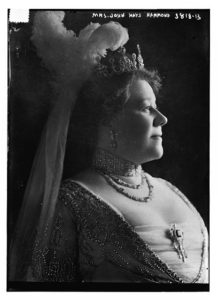
Why did Elder & Shepard publish a book about a guerilla war in southern Africa?
In 1901 the southern tip of Africa was immersed in a conflict known as the Boer War. The belligerents were the Boers, pastoral farmers who were descendants of the original 17th- and 18th-century Cape Dutch settlers, and the British Empire. The Boers lived in the Orange Free State and the Transvaal Republic, and the British controlled the Cape Colony. The Boer War was the culmination of more than a century of lesser conflict between the Boers and Britain, but the War’s immediate concern was who would control and benefit most from the lucrative gold mines in Witwatersrand, in the Transvaal. American engineer John Hays Hammond was plop in the middle of all this—along with his wife Natalie, the author of The Boers and the Uitlanders (1901).

John Hays Hammond (1855-1936) was born in California, where his father had prospected in the Gold Rush. Perhaps this rubbed off on the young John Hammond, for he studied science at Yale, then mining in Freiburg, Germany, where he met and married Natalie Harris (1859-1931). He soon was a respected mining engineer, working for, among others, Senator George Hearst. In 1893 the Hammonds moved to southern Africa where John helped open new mines in Witwatersrand. The Boers were happy to reap profits from the gold mines, but resented the presence of the British and American prospectors, whom they called uitlanders (“foreigners”). By 1895 Hammond was managing Cecil Rhodes‘s gold mines and had become quite wealthy.

It was then that history caught up with Hammond. Cecil Rhodes, Hammond, and others had formed the Johannesburg Reform Committee in the Transvaal in an attempt to secure basic rights for the uitlanders. The Committee was something of a sham, in that Rhodes knew President Paul Kruger would never accede to their demands, but his hope was that the British uitlander community would rise up against Kruger’s government. This did not happen, and after the botched Jamieson Raid of December 1895, most of the committee members, including Hammond, were arrested and thrown in jail. Hammond was one of four defendants who were sentenced to be hanged, but this was soon reduced to 15 years in prison, and later commuted entirely. Most of the ringleaders were shipped back to Britain, and the Hammonds returned to America in mid-1896.

Five years later, on 9 January 1901, Natalie Harris Hammond gave a speech at the Century Club of California (a private women’s club in San Francisco), and the text appeared later that year under the Elder & Shepard imprint as a vanity publication. She begins with a short history of the Boers in the Transvaal and the subsequent tension as the uitlanders flooded in during the gold rush. Her villain is Transvaal president Paul Kruger, whose railroad monopolies charged the uitlanders outrageous fares, and whose taxes on uitlanders verged on extortion. But her views of the Boers themselves—as well as the displaced native peoples—borders on racist:
The natural disaffection of the Boer against any governing control became thus accentuated to a degree that brought open rupture, and the so-called “Great Trek” was the result. … With scant food and small supply of water, surrounded by hostile tribes, these dogged Vortrekkers pushed along through wasted of arid land, sweltering under a brazen sun by day, tented at night by a strange and silent sky. For more than twenty years they wandered on, in search of their land of Canaan, leaving solitary graves to mark their course; for privation, fever and native assegais [spears] claimed a heavy toll. …
In ceaseless fight against wild beasts and savages, the courage of the Trekkers became tinctured with cunning. Habits of cleanliness inherited from their Dutch forefathers, and the spirit of thrift which came from their French ancestry, were thrown aside as useless burdens on that long and painful march.
The Transvaal Boer of today was evolved, uncleanly, improvident, cruel to the weak, crafty with the strong, ignorant, superstitious, strong in family affection, but lacking attachment to any special locality. Honesty and truthfulness towards others were virtues unknown to him, for with others he had little or no dealings. …
Neither President Kruger nor his Boers had the education or experience which would enable them to work out the questions which arose when the Uitlanders came in. A very small percentage of the Boers could even read or write.

As one would expect, Hammond is hardly the impartial historian. The British and American uitlanders were there to extract immense wealth from the gold fields, and were not above treachery and warmongering to attain those ends: the riches they extracted was not going to stay in Transvaal to benefit the Boers. This was still the golden age of British imperialist colonialism, and Queen Victoria was still on the throne (she died 13 days after Hammond’s talk at the Century Club). And in fact, the Boers would eventually lose the Boer War in 1902, and with the signing of the Treaty of Vereeniging the Boer republics became part of the British Empire.
When John Hammond returned to the United States in 1896, he was now both rich and famous. He became a professor of mining engineering at Yale in 1902, and also served as a very highly paid general manager for the Guggenheim Exploration Company, making him wealthier than ever. He became active in the Republican Party and was friends with several U.S. Presidents, particularly William Howard Taft. He was announced as a candidate for vice-president in 1908, but did not get many votes at the convention. Hammond appeared on the cover on Time magazine on 10 May 1926.
John and Natalie Hammond are buried in the Greenwood Cemetery in Brooklyn, New York.